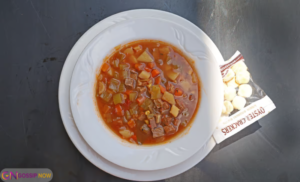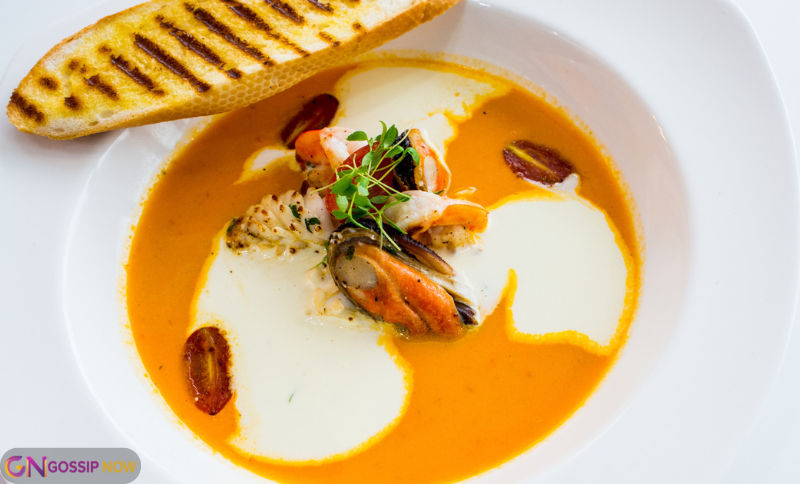There is something undeniably comforting about a warm bowl of soup — but have you ever wondered what exactly “soup du jour” means when you see it on a restaurant menu? You are not alone. This French phrase, often translated as “soup of the day,” carries more than just a fancy name. It represents creativity, freshness, and a daily culinary adventure that keeps both chefs and diners guessing. From creamy classics to bold broths made with seasonal ingredients, soup_du_jour is not just a dish — it is a statement.
In this guide, we will explore everything you need to know about soup_du_jour: its meaning, pronunciation, popular recipes, cultural significance, and even how to make your own at home. Whether you are a foodie, a chef, or just curious about what is in soup du jour, you are in the right place.
What is Soup du Jour?

If you have ever scanned a restaurant menu and spotted the term “Soup_du_Jour,” you may have paused for a moment. What exactly does it mean? Simply put, Soup-du_Jour is a French phrase that translates to “soup of the day.” It refers to a daily special soup made by the chef, often inspired by seasonal ingredients, culinary trends, or chef’s creativity.
Unlike fixed menu items, soup_du_jour changes regularly, offering variety and freshness. The idea is not just about serving soup — it’s about creating something unique, flavorful, and fitting for the moment.
A Quick Dive into the Meaning of “Soup du Jour”
The term “soup_du_jour” originates from French dining culture. In traditional French bistros, the menu du jour (menu of the day) would include select items not on the regular menu. It allowed chefs to experiment and use fresh, local ingredients.
So when we say “soup du jour meaning,” it does not just refer to a name — it embodies a philosophy of freshness and surprise in everyday cooking.
The Pop Culture Angle: “What is the Soup du Jour?” from Dumb and Dumber
Interestingly, for many people, their first introduction to the term may have come from a humorous scene in the classic movie Dumb and Dumber. In that moment, the character casually asks, “What is the soup_du_jour?” Subsequently, the waitress responds, “It’s the soup of the day.” As a result, he grins and enthusiastically replies, “Mmm… that sounds good. I’ll have that.”
Because of that iconic exchange, the phrase gained a unique pop culture flair. Consequently, it became one of the most frequently searched phrases online, especially for queries like “what is the soup_du_jour dumb and dumber?”
Why Restaurants Love Offering Soup du Jour
Restaurants love soup_du_jour for many reasons, and here’s why:
-
✅ Reduces waste: Chefs use ingredients nearing their shelf life.
-
✅ Creates excitement: Diners are curious to try “today’s special.”
-
✅ Allows creativity: Chefs get to experiment with flavors.
-
✅ Seasonal alignment: Warm soups in winter, lighter ones in summer.
-
✅ Keeps the menu dynamic: Repeat customers have something new to look forward to.
Common Types of Soup du Jour (You’ll Actually Love)
There’s no limit to what soup_du_jour can be. Here are some popular ones that frequently appear in restaurants:
🌱 Vegetable-Based Soups
-
Cream of Mushroom
-
Roasted Butternut Squash
-
French Onion Soup
-
Tomato Basil
🍗 Meat-Based Soups
-
Chicken Tortilla
-
Beef Barley
-
Ham and Split Pea
-
Turkey Noodle
🐟 Seafood Soups
-
New England Clam Chowder
-
Shrimp Bisque
-
Crab and Corn Soup
Each of these can be prepared as a soup_du_jour depending on available ingredients and customer preferences.
How to Make a Delicious Soup du Jour at Home
One of the best things about soup_du_jour recipes is how versatile they are. You do not need to stick to a rigid formula. Instead, follow these steps and adjust according to your ingredients and taste preferences.
🥕 Step-by-Step Soup du Jour Recipe Framework
-
Choose a Base:
-
Broth (chicken, beef, or vegetable)
-
Cream or coconut milk for a richer version
-
-
Pick a Star Ingredient:
-
Pumpkin, carrots, mushrooms, tomatoes, spinach, etc.
-
-
Add Protein (Optional):
-
Shredded chicken, beans, lentils, or tofu
-
-
Flavor Boosters:
-
Garlic, onions, herbs, spices like cumin or paprika
-
-
Simmer Time:
-
Let it simmer for 30–45 minutes
-
-
Final Touch:
-
Blend for creaminess or leave chunky
-
Garnish with fresh herbs or croutons
-
You can even make your own “soup_du_jour recipe book” by experimenting and recording what works best for your family or guests.
The Importance of Soup du Jour in Culinary Culture
At first glance, soup du jour may appear to be a simple concept. However, when you look deeper, it holds a much more meaningful place in culinary culture. In fact, it represents a chef’s creativity, resourcefulness, and close relationship with seasonal produce. As a result, this ever-changing dish becomes more than just a meal — it turns into a daily edible poem composed with ingredients instead of words.
Consequently, when home chefs and professionals alike embrace this flexible cooking style, they begin to:
-
First and foremost, cook intuitively rather than following rigid recipes
-
Additionally, waste less food by using what is already available
-
Furthermore, appreciate seasonal eating as a sustainable practice
-
Lastly, elevate humble ingredients into something extraordinary
Soup du Jour Ingredients You Should Always Keep at Home
Whether you’re a home cook or a restaurant chef, here are go-to soup du jour ingredients to keep stocked:
-
Olive oil or butter
-
Onions and garlic
-
Broth cubes or ready-made stock
-
Canned tomatoes
-
Carrots, celery, and potatoes
-
Herbs like thyme, parsley, bay leaf
-
Salt, pepper, paprika, chili flakes
-
Cream or milk (for creamy soups)
These pantry staples make it easy to whip up a heartwarming soup_du_jour anytime.
Fun Twist: Naming Your Soup du Jour
 On top of everything else, naming your soup du jour creatively can take the experience to the next level. Whether you run a restaurant or simply enjoy hosting guests at home, a thoughtful name can turn an ordinary dish into something unforgettable.
On top of everything else, naming your soup du jour creatively can take the experience to the next level. Whether you run a restaurant or simply enjoy hosting guests at home, a thoughtful name can turn an ordinary dish into something unforgettable.
Rather than writing the plain and predictable “Soup of the Day,” consider using creative titles such as:
-
“Winter Warm-Up: Creamy Leek & Potato” – Ideal for chilly nights
-
“Sun-Kissed Summer Tomato Bliss” – Perfect for sunny afternoons
-
“Grandma’s Secret Chicken Soup” – Nostalgic and heartwarming
-
“Chef’s Pick: Spicy Thai Coconut” – Exotic with a touch of heat
Altogether, these names add not only character and emotion, but also a touch of curiosity to the menu, making your dish significantly more appealing.
How to Pronounce “Soup du Jour” (Yes, It Matters!)
You would be surprised how often people ask: “Soup_du_jour pronunciation?”
Correctly pronounced in French, it’s:
/suːp du ʒʊr/
That last word “jour” sounds like “zhoor” – soft, smooth and elegant.
So next time you order it, say it with flair!
Final Thoughts
Whether you’re discovering what is soup_du_jour for the first time, or you have been savoring it for years, there’s something magical about it. It’s a dish that changes daily, but it always delivers comfort, flavor, and freshness.
With just a few ingredients and a touch of creativity, you can turn your leftovers into a gourmet dish — that’s the magic of soup_du_jour food.
So, next time you see “soup_du_jour” on a menu, don’t hesitate. Go ahead and try it. After all, you might just discover your new favorite.
FAQs
1. What does “soup du jour” mean?
It means “soup of the day” in French, typically a daily special soup made fresh using seasonal ingredients.
2. How do you pronounce soup du jour?
It is pronounced as /suːp du ʒʊr/, where “jour” sounds like “zhoor.”
3. Is soup du jour always the same at a restaurant?
No, it changes daily depending on the chef’s choice and available ingredients.
4. Can I make soup du jour at home without a recipe?
Yes! You can improvise with whatever fresh ingredients you have at home.
5. What are some popular soup du jour recipes?
Tomato basil, chicken tortilla, clam chowder, and roasted squash are common favorites.






